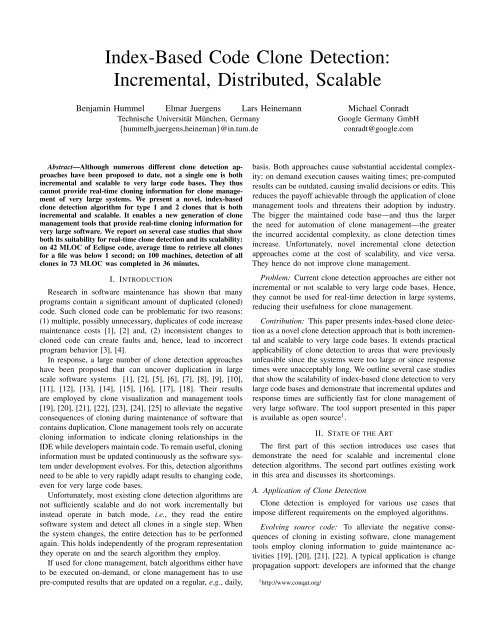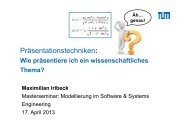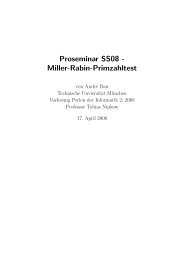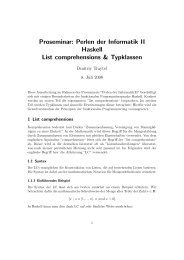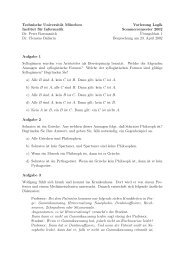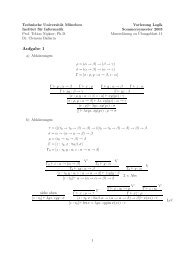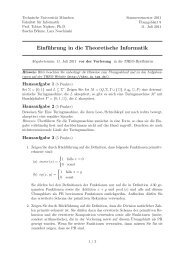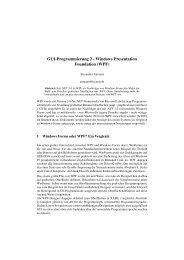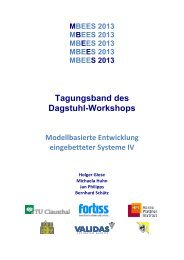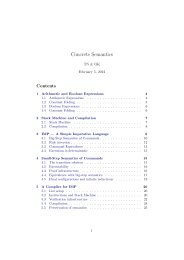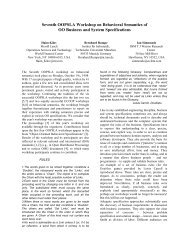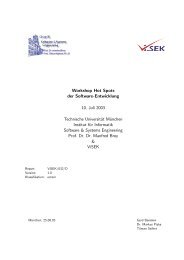Index-Based Code Clone Detection - Software and Systems ...
Index-Based Code Clone Detection - Software and Systems ...
Index-Based Code Clone Detection - Software and Systems ...
- No tags were found...
You also want an ePaper? Increase the reach of your titles
YUMPU automatically turns print PDFs into web optimized ePapers that Google loves.
<strong>Index</strong>-<strong>Based</strong> <strong>Code</strong> <strong>Clone</strong> <strong>Detection</strong>:Incremental, Distributed, ScalableBenjamin Hummel Elmar Juergens Lars HeinemannTechnische Universität München, Germany{hummelb,juergens,heineman}@in.tum.deMichael ConradtGoogle Germany GmbHconradt@google.comAbstract—Although numerous different clone detection approacheshave been proposed to date, not a single one is bothincremental <strong>and</strong> scalable to very large code bases. They thuscannot provide real-time cloning information for clone managementof very large systems. We present a novel, index-basedclone detection algorithm for type 1 <strong>and</strong> 2 clones that is bothincremental <strong>and</strong> scalable. It enables a new generation of clonemanagement tools that provide real-time cloning information forvery large software. We report on several case studies that showboth its suitability for real-time clone detection <strong>and</strong> its scalability:on 42 MLOC of Eclipse code, average time to retrieve all clonesfor a file was below 1 second; on 100 machines, detection of allclones in 73 MLOC was completed in 36 minutes.I. INTRODUCTIONResearch in software maintenance has shown that manyprograms contain a significant amount of duplicated (cloned)code. Such cloned code can be problematic for two reasons:(1) multiple, possibly unnecessary, duplicates of code increasemaintenance costs [1], [2] <strong>and</strong>, (2) inconsistent changes tocloned code can create faults <strong>and</strong>, hence, lead to incorrectprogram behavior [3], [4].In response, a large number of clone detection approacheshave been proposed that can uncover duplication in largescale software systems [1], [2], [5], [6], [7], [8], [9], [10],[11], [12], [13], [14], [15], [16], [17], [18]. Their resultsare employed by clone visualization <strong>and</strong> management tools[19], [20], [21], [22], [23], [24], [25] to alleviate the negativeconsequences of cloning during maintenance of software thatcontains duplication. <strong>Clone</strong> management tools rely on accuratecloning information to indicate cloning relationships in theIDE while developers maintain code. To remain useful, cloninginformation must be updated continuously as the software systemunder development evolves. For this, detection algorithmsneed to be able to very rapidly adapt results to changing code,even for very large code bases.Unfortunately, most existing clone detection algorithms arenot sufficiently scalable <strong>and</strong> do not work incrementally butinstead operate in batch mode, i.e., they read the entiresoftware system <strong>and</strong> detect all clones in a single step. Whenthe system changes, the entire detection has to be performedagain. This holds independently of the program representationthey operate on <strong>and</strong> the search algorithm they employ.If used for clone management, batch algorithms either haveto be executed on-dem<strong>and</strong>, or clone management has to usepre-computed results that are updated on a regular, e.g., daily,basis. Both approaches cause substantial accidental complexity:on dem<strong>and</strong> execution causes waiting times; pre-computedresults can be outdated, causing invalid decisions or edits. Thisreduces the payoff achievable through the application of clonemanagement tools <strong>and</strong> threatens their adoption by industry.The bigger the maintained code base—<strong>and</strong> thus the largerthe need for automation of clone management—the greaterthe incurred accidental complexity, as clone detection timesincrease. Unfortunately, novel incremental clone detectionapproaches come at the cost of scalability, <strong>and</strong> vice versa.They hence do not improve clone management.Problem: Current clone detection approaches are either notincremental or not scalable to very large code bases. Hence,they cannot be used for real-time detection in large systems,reducing their usefulness for clone management.Contribution: This paper presents index-based clone detectionas a novel clone detection approach that is both incremental<strong>and</strong> scalable to very large code bases. It extends practicalapplicability of clone detection to areas that were previouslyunfeasible since the systems were too large or since responsetimes were unacceptably long. We outline several case studiesthat show the scalability of index-based clone detection to verylarge code bases <strong>and</strong> demonstrate that incremental updates <strong>and</strong>response times are sufficiently fast for clone management ofvery large software. The tool support presented in this paperis available as open source 1 .II. STATE OF THE ARTThe first part of this section introduces use cases thatdemonstrate the need for scalable <strong>and</strong> incremental clonedetection algorithms. The second part outlines existing workin this area <strong>and</strong> discusses its shortcomings.A. Application of <strong>Clone</strong> <strong>Detection</strong><strong>Clone</strong> detection is employed for various use cases thatimpose different requirements on the employed algorithms.Evolving source code: To alleviate the negative consequencesof cloning in existing software, clone managementtools employ cloning information to guide maintenance activities[19], [20], [21], [22]. A typical application is changepropagation support: developers are informed that the change1 http://www.conqat.org/
they are currently performing is in cloned code <strong>and</strong> shouldpossibly be applied to the clones as well. Since empiricalstudies have demonstrated that unintentionally inconsistentupdates to cloned code often represent faults [3], such toolspromise to reduce the number of cloning-related bugs. Theleverage they can provide, however, depends heavily on theaccuracy of the cloning information they operate on. As thesoftware evolves, so do its contained clones. Consequently,cloning information needs to be updated continuously toremain accurate.For large systems, rerunning detection on the entire systemafter each change is prohibitively expensive. Instead, clonemanagement computes cloning information on a regular basis,e.g., during a nightly build. Unfortunately, it quickly becomesout-dated once a developer changes code. With out-datedinformation, however, clone management tools cannot leveragetheir full value: clone positions can have changed, causingeffort for their manual location; new clones might be missing<strong>and</strong> thus escape management.To avoid such accidental complexity, clone detection algorithmsneed to be able to very quickly adapt cloninginformation to changes in the source code.Very large code bases: For several use cases, clone detectionis not employed on a single system, but on families ofsystems, increasing the size of the analyzed code.Cross-product cloning analysis is used across a company’sproduct portfolio, across a software ecosystem or for softwareproduct lines, to discover reusable code fragments that arec<strong>and</strong>idates for consolidation [26]. For large products, theoverall code size can be substantial. Microsoft Windows Vista,e.g., comprises 50 MLOC [27].To discover copyright infringement or license violations,clone detection is employed to discover duplication betweenthe code base maintained by a company <strong>and</strong> a collection ofopen source projects or software from other parties[10], [28].To provide comprehensive results, different versions of theindividual projects might need to be included, resulting incode bases that can easily exceed several hundred MLOC.For these use cases, clone detection algorithms need to scaleto very large code bases.Summary: The above use cases make two important requirementsfor clone detection apparent: a) incremental detectionto be able to quickly adapt cloning information to changingsource code <strong>and</strong> b) scalability to large code bases. Ideally, asingle algorithm should support both, in order to be applicableto clone management of large code bases.B. Existing <strong>Clone</strong> <strong>Detection</strong> ApproachesA multitude of clone detection approaches have been proposed.They differ in the program representation they operateon <strong>and</strong> in the search algorithms they employ to identifysimilar code fragments. Independent of whether they operateon text [7], [11], [15], tokens [5], [10], [16], ASTs [6],[12], [14] or program dependence graphs [9], [8], <strong>and</strong> independentof whether they employ textual differencing [11],[15], suffix-trees [5], [10], [16], subtree hashing [6], [14],anti-unification[29], frequent itemset mining [13], slicing [8],isomorphic subgraph search [9] or a combination of differentphases [30], they operate in batch mode: the entire system isprocessed in a single step by a single machine.The scalability of these approaches is limited by the amountof resources available on a single machine. The upper sizelimit on the amount of code that can be processed variesbetween approaches, but is insufficient for very large codebases. Furthermore, if the analyzed source code changes,batch approaches require the entire detection to be rerun toachieve up-to-date results. Hence, these approaches are neitherincremental nor sufficiently scalable.Incremental or real-time detection: Göde <strong>and</strong> Koschke [17]proposed the first incremental clone detection approach. Theyemploy a generalized suffix-tree that can be updated efficientlywhen the source code changes. The amount of effort requiredfor the update only depends on the size of the change, not thesize of the code base. Unfortunately, generalized suffix-treesrequire substantially more memory than read-only suffix-trees,since they require additional links that are traversed during theupdate operations. Since generalized suffix-trees are not easilydistributed across different machines, the memory requirementsrepresent the bottleneck w.r.t. scalability. Consequently,the improvement in incremental detection comes at the costof substantially reduced scalability.Yamashina et al. [31] propose a tool called SHINOBI thatprovides real-time cloning information to developers inside theIDE. Instead of performing clone detection on dem<strong>and</strong> (<strong>and</strong>incurring waiting times for developers), SHINOBI maintains asuffix-array on a server from which cloning information for afile opened by a developer can be retrieved efficiently. Unfortunately,the authors do not approach suffix-array maintenancein their work. Real-time cloning information hence appears tobe limited to an immutable snapshot of the software. We thushave no indication that their approach works incrementally.Nguyen et al. [32] present an AST-based incremental approachthat computes characteristic vectors for all subtreesof the AST for a file. <strong>Clone</strong>s are detected by searching forsimilar vectors. If the analyzed software changes, vectors formodified files are simply recomputed. As the algorithm isnot distributed, its scalability is limited by the amount ofmemory available on a single machine. A related approach thatalso employs AST subtree hashing is proposed by Chilowiczet al. [33]. Both approaches require parsers that are, unfortunately,hard to obtain for legacy languages such as PL/I orCOBOL [34]. However, such systems often contain substantialamounts of cloning [3]—making clone management for themespecially relevant. Instead, our approach does not require aparser.Scalable detection: Livieri et al. [35] propose a generaldistribution model that distributes clone detection across manymachines to improve scalability. Their distribution modelessentially partitions source code into pieces small enough(e.g., 15 MB) to be analyzed on a single machine. <strong>Clone</strong>
Fig. 1.The original file (left), its normalization (center), <strong>and</strong> the corresponding clone index (right).indices which allow persisting the clone index over time <strong>and</strong>processing amounts of code which are too large to fit into mainmemory. The latter may be based on database systems, or onone of the many optimized (<strong>and</strong> often distributed) key-valuestores [37], [38].In Fig. 1, the correspondence between an input file “X.j” 4<strong>and</strong> the clone index is visualized for a chunk length of 5. Thefield which requires most explanation is the sequence hash.The reason for using statement sequences in the index insteadof individual statements is that the statement sequences aremore unique (two identical statement sequences are less likelythan two identical statements) <strong>and</strong> are already quite similar tothe clones. If there are two entries in the index with the samesequence, we already have a clone of length at least n. Thereason for storing a hash in the index instead of the entiresequence is for saving space, as this way the size of the index isindependent of the choice of n, <strong>and</strong> usually the hash is shorterthan the sequence’s contents even for small values of n. We usethe MD5 hashing algorithm [39] which calculates 128 bit hashvalues <strong>and</strong> is typically used in cryptographic applications, suchas the calculation of message signatures. As our algorithmonly works on the hash values, several statement sequenceswith the same MD5 hash value would cause false positivesin the reported clones. While there are cryptographic attackswhich can generate messages with the same hash value [40],the case of different statement sequences producing the sameMD5 hash is so unlikely in our setting, that it can be neglectedfor practical purposes.C. <strong>Clone</strong> Retrieval<strong>Clone</strong> retrieval is the process of extracting all clones for asingle file from the index. Usually we assume that the file iscontained in the index, but of course the same process canbe applied to find clones between the index <strong>and</strong> an externalfile as well. Tuples with the same sequence hash alreadyindicate clones with a length of at least n (where n is theglobally constant chunk length). The goal of clone retrievalis to report only maximal clones, i.e., clone groups whichare not completely contained in another clone group. Theoverall algorithm, which calculates the longest subsequencesof duplicated chunks, is sketched in Fig. 2 <strong>and</strong> explained inmore detail next.The first step (up to Line 6) is to create the list c ofduplicated chunks. This list stores for each statement of the4 We use the name X.j instead of X.java as an abbreviation in the figures.1: function report<strong>Clone</strong>s (filename)2: let f be the list of tuples corresponding to filenamesorted by statement index either read fromthe index or calculated on the fly3: let c be a list with c(0) = ∅4: for i := 1 to length(f) do5: retrieve tuples with same sequence hash as f(i)6: store this set as c(i)7: for i := 1 to length(c) do8: if |c(i)| < 2 or c(i) ˜⊆c(i − 1) then9: continue with next loop iteration10: let a := c(i)11: for j := i + 1 to length(c) do12: let a ′ := a˜∩c(j)13: if |a ′ | < |a| then14: report clones from c(i) to a (see text)15: a := a ′16: if |a| < 2 or a ˜⊆c(i − 1) then17: break inner loopFig. 2.Fig. 3.<strong>Clone</strong> Retrieval AlgorithmLookups performed for retrievalinput file all tuples from the index with the same sequence hashas the sequence found in the file. The index used to access thelist c corresponds to the statement index in the input file. Thesetup is depicted in Fig. 3. There is a clone in X.j of length10 (6 tuples with chunk length 5) with the file Y.j, <strong>and</strong> a cloneof length 7 with both Y.j <strong>and</strong> Z.j.In the main loop (starting from Line 7), we first checkwhether any new clones might start at this position. If thereis only a single tuple with this hash (which has to belongto the inspected file at the current location) we skip this loop
iteration. The same holds if all tuples at position i have alreadybeen present at position i − 1, as in this case any clone groupfound at position i would be included in a clone group startingat position i − 1. Although we use the subset operator in thealgorithm description, this is not really a subset operation,as of course the statement index of the tuples in c(i) will beincreased by 1 compared to the corresponding ones in c(i−1)<strong>and</strong> the hash <strong>and</strong> info fields will differ.The set a introduced in Line 10 is called the active set <strong>and</strong>contains all tuples corresponding to clones which have not yetbeen reported. At each iteration of the inner loop the set ais reduced to tuples which are also present in c(j); again theintersection operator has to account for the increased statementindex <strong>and</strong> different hash <strong>and</strong> info fields. The new value isstored in a ′ . <strong>Clone</strong>s are only reported, if tuples are lost inLine 12, as otherwise all current clones could be prolongedby one statement. <strong>Clone</strong> reporting matches tuples that, aftercorrection of the statement index, appear in both c(i) <strong>and</strong> a;each matched pair corresponds to a single clone. Its locationcan be extracted from the filename <strong>and</strong> info fields. All clonesin a single reporting step belong to one clone group. Line 16early exits the inner loop if either no more clones are startingfrom position i (i.e., a is too small), or if all tuples from ahave already been in c(i − 1), corrected for statement index.In this case they have already been reported in the previousiteration of the outer loop.This algorithm returns all clone groups with at least oneclone instance in the given file <strong>and</strong> with a minimal lengthof chunk length n. Shorter clones cannot be detected withthe index, so n must be chosen equal to or smaller than theminimal clone length (typically 7 or 10). Of course, reportedclones can be easily filtered to only include clones with alength l > n.One problem of this algorithm is that clone classes withmultiple instances in the same file are encountered <strong>and</strong> reportedmultiple times. Furthermore, when calculating the clonegroups for all files in a system, clone groups will be reportedmore than once as well. Both cases can be avoided, bychecking whether the first element of a ′ (with respect to afixed order) is equal to f(j) <strong>and</strong> only report in this case.Complexity: For the discussion of complexity we denote thenumber of statements by |f| <strong>and</strong> the number of tuples returnedfor its i-th statement by |c(i)| (just as in the algorithm). Thenumber of tuples in the index is denoted by N. For the first partof the algorithm the number of queries to the index is exactly|f|+1. Assuming that a single query returning q elements canbe performed in O(q + log N), which is true for typical indeximplementations, the first part up to Line 6 requires at mosttime O( ∑ i|c(i)| + |f| log N).The set operations used in the algorithm are easily implementedin linear time if the sets c(i) are managed as sortedlists. Thus, the running time of the part starting from Line 7is bounded by O(|f| 2 max c(i)), which seems to be ratherinefficient. It should be noted, however, that the worst-caseis hard to construct <strong>and</strong> nearly never appears in real-worldsystems. For both the case that a file contains not a singleclone (i.e., |c(i)| = 1 for all i), <strong>and</strong> that an exact duplicateexists for a file but no clone to other files, the runtime ofthis part improves to O(|f|). As the overall performance ofthe clone retrieval algorithm strongly depends on the structureof the analyzed system, practical measurements are important,which are reported on in Sec. IV.D. <strong>Index</strong> MaintenanceBy the term index maintenance we underst<strong>and</strong> all stepsrequired to keep the index up to date in the presence ofcode changes. For index maintenance, only two operationsare needed, namely addition <strong>and</strong> removal of single files.Modifications of files can be reduced to a remove operationfollowed by an addition 5 <strong>and</strong> index creation is just addition ofall existing files starting from an empty index. In the indexbasedmodel, both operations are extremely simple. To adda new file, it has to be read <strong>and</strong> preprocessed to produceits sequence of normalized statements. From this sequence,all possible contiguous sequences of length n (where n isthe chunk length) are generated, which are then hashed <strong>and</strong>inserted as tuples into the index. Similarly, the removal ofa file consists of the removal of all tuples which contain therespective file. Depending on the implementation of the index,addition <strong>and</strong> removal of tuples can cause additional processingsteps (such as rebalancing search trees, or recovering freeddisk space), but these are not considered here.We may assume that preprocessing time of a file is linear inits size 6 . Depending on the index structure used, addition <strong>and</strong>removal of single tuples typically requires expected amortizedprocessing time O(1) (e.g., for hash tables), or O(log N)where N is the number of stored tuples (e.g., for search trees).Thus, the index maintenance operations can be expected to runin linear time or time O(|f| log N).E. Implementation ConsiderationsThere are two factors affecting the processing time requiredfor index maintenance <strong>and</strong> clone retrieval: the chunk size n,<strong>and</strong> the implementation of the clone index. The size of naffects both index maintenance, which is more efficient forsmall n, <strong>and</strong> clone retrieval, which benefits from larger n.Additionally, n has to be chosen smaller than the minimalclone length, as only clones consisting of at least n statementscan be found using the index. For practical purposes weusually choose n smaller than or equal to the minimal clonelength we are interested in. Values of n smaller than 5 typicallylead to a large number of tuples with the same hash value anthus severely affect clone retrieval.The index implementation is affected both by the choice ofthe data structure <strong>and</strong> the kind of storage medium used. As5 This simplification makes sense only if a single file is small compared tothe entire code base, which holds for most systems. If a system only consistsof a small number of huge files, more refined update operations would berequired.6 The preprocessing phase of most token-based clone detectors runs in lineartime, as both tokenization <strong>and</strong> normalization with constant look-ahead arelinear time operations.
many clones can cause some of these file lists to requiresubstantially longer processing times, causing this saturationeffect. The algorithm thus scales well up to a certain number ofmachines. It seems that using more than about 30 machines forretrieval does not make sense for a code base of the given size.However, the large job processing 2.9 GLOC demonstrates the(absence of) limits for the index construction part.Since a substantial part of the time is spent on networkcommunication, these times may not be compared with thoseof the previous section. Instead, a better comparison wouldbe with [35], where about 400 MLOC were processed on 80machines within 51 hours. While our code base is about afactor of 5.5 smaller, using 80 machines, index-based detectionis 86 times faster. Using only ten machines, it is still a factorof 16.5 faster (on the smaller code base). For a conclusivecomparison, we would have to run both approaches on thesame code <strong>and</strong> hardware. However, these numbers indicatethat the gained speedup is not only due to reduced code sizeor the use of slightly different hardware, but also because ofalgorithmic improvement.C. Real Time <strong>Clone</strong> <strong>Detection</strong>This case study investigates suitability for real-time clonedetection on large code that is modified continuously.<strong>Index</strong> implementation: We used a persistent clone indeximplementation based on Berkeley DB 14 , a high-performanceembedded database.Design <strong>and</strong> Procedure: To evaluate the support for real timeclone management, we measured the time required to (1) buildthe index, (2) update the index in response to changes to thesystem, <strong>and</strong> (3) query the index. For this, we used code ofversion 3.3 of the Eclipse SDK consisting of 209.312 Java fileswhich comprise 42.693.793 lines of code. Since our approachis incremental, a full indexing has to happen only once. Toassess the performance of the index building, we constructedthe index for the Eclipse source code <strong>and</strong> measured the overalltime required. Furthermore, to evaluate the incremental updatecapabilities of the index, we removed 1,000 r<strong>and</strong>omly selectedfiles from the Eclipse index <strong>and</strong> re-added them afterwards.Likewise, for the query capability, we queried the index forthe clone classes of 1,000 r<strong>and</strong>omly selected files.Results: On the test system, the index creation process forthe Eclipse SDK including writing the clone index to thedatabase took 7 hours <strong>and</strong> 4 minutes. The clone index for theEclipse SDK occupied 5.6 GB on the hard disk. In comparison,the source code itself needed 1.8 GB disk space, i.e., the indexused about 3 times the space of the original system. The testsystem was able to answer a query for a single file at anaverage time of 0.91 seconds, <strong>and</strong> a median query time of0.21 seconds. Only 14 of the 1000 files had a query time ofover 10 seconds. On average they had a size of 3 kLOC <strong>and</strong>350 clones. The update of the clone index including writing it14 http://www.oracle.com/technology/products/berkeley-db/index.htmlTABLE IIICLONE MANAGEMENT PERFORMANCE<strong>Index</strong> creation (complete)<strong>Index</strong> query (per file)<strong>Index</strong> update (per file)7 hr 4 min0.21 sec median0.91 sec average0.85 sec averageto the database took 0.85 seconds on average per file. Table IIIillustrates these performance measurement results at a glance.Discussion: The results from this case study indicate thatour approach is capable of supporting real time clone management.The average time for an index query is, in our opinion,fast enough to support interactive display of clone informationwhen a source file is opened in the IDE. Furthermore, theperformance of index updates allows for continuous indexmaintenance.V. CONCLUSION AND FUTURE WORKThis paper presents a novel clone detection approach thatemploys an index for efficient clone retrieval. To the best ofour knowledge, it is the first approach that is at the same timeincremental <strong>and</strong> scalable to very large code bases.The clone index not only allows the retrieval of all clonescontained in a system, but also supports the efficient retrievalof the clones that cover a specific file. This allows clonemanagement tools to provision developers in real-time withcloning information while they maintain code. For a case studyon 42 MLOC of Eclipse, average retrieval time was below1 second, demonstrating applicability to very large software.Since the clone index can be updated incrementally while thesoftware changes, cloning information can be kept accurate atall times.The clone index can be distributed across different machines,enabling index creation, maintenance <strong>and</strong> clone retrievalto be parallelized. <strong>Index</strong>-based clone detection thusimposes no limits on scalability—it can simply be improvedby adding hardware resources—while retaining its abilityfor incremental updates. For the case study, 100 machinesperformed clone detection in 73 MLOC of open source codein 36 minutes.For the analyzed systems, index-based clone detection (employingan in-memory index) outperforms suffix-tree-basedclone detection. This indicates that the index-based detectionalgorithm can potentially substitute suffix-tree-based algorithms,which are employed by many existing clone detectors.For future work, we plan to develop algorithms that employthe clone index to detect type 3 clones 15 . One approach is touse hash functions that are robust to further classes of changes,such as e.g., n-gram based hashing as proposed by Smith <strong>and</strong>Horwitz in [42]. Another approach is to use locality sensitivehashing, as e.g., employed by [14] <strong>and</strong> adapt the retrieval toalso find similar, not only identical, hashes. Furthermore, based15 Type 3 clones can differ beyond the token level; statements can beinserted, changed or removed [1].
on our existing tool support for clone detection in naturallanguage documents [43], we plan to employ the index-basedapproach for plagiarism detection in text documents.Our implementation of index-based clone detection (exceptthe Google-specific parts) is available as open source.ACKNOWLEDGMENTSThe authors want to thank Birgit Penzenstadler, FlorianDeissenboeck <strong>and</strong> Daniel Ratiu for inspiring discussions <strong>and</strong>helpful comments on the paper.REFERENCES[1] R. Koschke, “Survey of research on software clones,” in Duplication,Redundancy, <strong>and</strong> Similarity in <strong>Software</strong>, 2007.[2] C. K. Roy <strong>and</strong> J. R. Cordy, “A survey on software clone detectionresearch,” Queen’s University, Kingston, Canada, Tech. Rep. 2007-541,2007.[3] E. Juergens, F. Deissenboeck, B. Hummel, <strong>and</strong> S. Wagner, “Do codeclones matter?” in ICSE’09, 2009.[4] T. Bakota, R. Ferenc, <strong>and</strong> T. Gyimothy, “<strong>Clone</strong> smells in softwareevolution,” in ICSM’07, 2007.[5] B. S. Baker, “On finding duplication <strong>and</strong> near-duplication in largesoftware systems,” in WCRE’95, 1995.[6] I. D. Baxter, A. Yahin, L. Moura, M. Sant’Anna, <strong>and</strong> L. Bier, “<strong>Clone</strong>detection using abstract syntax trees,” in ICSM’98, 1998.[7] S. Ducasse, M. Rieger, <strong>and</strong> S. Demeyer, “A language independentapproach for detecting duplicated code,” in ICSM’99, 1999.[8] R. Komondoor <strong>and</strong> S. Horwitz, “Using slicing to identify duplication insource code,” in SAS’01, 2001.[9] J. Krinke, “Identifying similar code with program dependence graphs,”in WCRE’01, 2001.[10] T. Kamiya, S. Kusumoto, <strong>and</strong> K. Inoue, “CCFinder: a multilinguistictoken-based code clone detection system for large scale source code,”IEEE Trans. Softw. Eng., vol. 28, no. 7, pp. 654–670, 2002.[11] J. R. Cordy, T. R. Dean, <strong>and</strong> N. Synytskyy, “Practical languageindependentdetection of near-miss clones,” in CASCON’04, 2004.[12] R. Koschke, R. Falke, <strong>and</strong> P. Frenzel, “<strong>Clone</strong> detection using abstractsyntax suffix trees,” in WCRE’06, 2006.[13] Z. Li, S. Lu, S. Myagmar, <strong>and</strong> Y. Zhou, “CP-Miner: Finding copy-paste<strong>and</strong> related bugs in large-scale software code,” IEEE Trans. Softw. Eng,vol. 32, no. 3, pp. 176–192, 2006.[14] L. Jiang, G. Misherghi, Z. Su, <strong>and</strong> S. Glondu, “DECKARD: Scalable<strong>and</strong> accurate tree-based detection of code clones,” in ICSE’07, 2007.[15] C. K. Roy <strong>and</strong> J. R. Cordy, “NICAD: Accurate detection of near-missintentional clones using flexible pretty-printing <strong>and</strong> code normalization,”in ICPC’08, 2008.[16] E. Juergens, F. Deissenboeck, <strong>and</strong> B. Hummel, “<strong>Clone</strong>detective – aworkbench for clone detection research,” in ICSE’09, 2009.[17] N. Göde <strong>and</strong> R. Koschke, “Incremental clone detection,” in CSMR’09,2009.[18] J. Mayr<strong>and</strong>, C. Leblanc, <strong>and</strong> E. Merlo, “Experiment on the automaticdetection of function clones in a software system using metrics,” inICSM’96, 1996.[19] R. Koschke, “Frontiers of software clone management,” in FoSM’08,2008.[20] P. Jablonski <strong>and</strong> D. Hou, “CReN: a tool for tracking copy-<strong>and</strong>-paste codeclones <strong>and</strong> renaming identifiers consistently in the IDE,” in Eclipse’07,2007.[21] E. Duala-Ekoko <strong>and</strong> M. P. Robillard, “Tracking code clones in evolvingsoftware,” in ICSE’07, 2007.[22] E. Juergens <strong>and</strong> F. Deissenboeck, “How much is a clone?” in SQM’10,2010.[23] M. Rieger, S. Ducasse, <strong>and</strong> M. Lanza, “Insights into system-wide codeduplication,” in WCRE’04, 2004.[24] M. de Wit, A. Zaidman, <strong>and</strong> A. van Deursen, “Managing code clonesusing dynamic change tracking <strong>and</strong> resolution,” in ICSM’09, 2009.[25] C. J. Kapser <strong>and</strong> M. W. Godfre, “Improved tool support for theinvestigation of duplication in software,” in ICSM’05, 2005.[26] T. Mende, F. Beckwermert, R. Koschke, <strong>and</strong> G. Meier, “Supporting thegrow-<strong>and</strong>-prune model in software product lines evolution using clonedetection,” in CSMR’08, 2008.[27] N. Nagappan, B. Murphy, <strong>and</strong> V. Basili, “The influence of organizationalstructure on software quality: an empirical case study,” in ICSE’08, 2008.[28] D. German, M. Di Penta, Y. Guéhéneuc, <strong>and</strong> G. Antoniol, “<strong>Code</strong>siblings: Technical <strong>and</strong> legal implications of copying code betweenapplications,” in MSR’09, 2009.[29] P. Bulychev <strong>and</strong> M. Minea, “An evaluation of duplicate code detectionusing anti-unification,” in IWSC’09, 2009.[30] Y. Jia, D. Binkley, M. Harman, J. Krinke, <strong>and</strong> M. Matsushita, “K<strong>Clone</strong>:a proposed approach to fast precise code clone detection,” in IWSC’09,2009.[31] S. Kawaguchi, T. Yamashina, H. Uwano, K. Fushida, Y. Kamei,M. Nagura, <strong>and</strong> H. Iida, “SHINOBI: A Tool for Automatic <strong>Code</strong> <strong>Clone</strong><strong>Detection</strong> in the IDE,” in WCRE’09, 2009.[32] T. T. Nguyen, H. A. Nguyen, J. M. Al-Kofahi, N. H. Pham, <strong>and</strong>T. N. Nguyen, “Scalable <strong>and</strong> incremental clone detection for evolvingsoftware,” ICSM’09, 2009.[33] M. Chilowicz, É. Duris, <strong>and</strong> G. Roussel, “Syntax tree fingerprinting forsource code similarity detection,” in Proc. of ICPC’09, 2009.[34] R. Lämmel <strong>and</strong> C. Verhoef, “Semi-automatic grammar recovery,” Softw.Pract. Exp., vol. 31, no. 15, pp. 1395–1438, 2001.[35] S. Livieri, Y. Higo, M. Matsushita, <strong>and</strong> K. Inoue, “Very-large scalecode clone analysis <strong>and</strong> visualization of open source programs usingdistributed CCFinder: D-CCFinder,” in ICSE’07, 2007.[36] D. E. Knuth, The Art of Computer Programming, 2nd ed. Addison-Wesley, 1997, vol. 3: Sorting <strong>and</strong> Searching.[37] F. Chang, J. Dean, S. Ghemawat, W. C. Hsieh, D. A. Wallach, M. Burrows,T. Ch<strong>and</strong>ra, A. Fikes, <strong>and</strong> R. E. Gruber, “Bigtable: A distributedstorage system for structured data,” ACM Trans. Comput. Syst., vol. 26,no. 2, 2008.[38] G. DeC<strong>and</strong>ia, D. Hastorun, M. Jampani, G. Kakulapati, A. Lakshman,A. Pilchin, S. Sivasubramanian, P. Vosshall, <strong>and</strong> W. Vogels, “Dynamo:Amazon’s highly available key-value store,” in SOSP’07, 2007.[39] R. Rivest, “The MD5 Message-Digest Algorithm,” RFC 1321 (Informational),Internet Engineering Task Force, 1992.[40] M. Stevens, A. Sotirov, J. Appelbaum, A. K. Lenstra, D. Molnar, D. A.Osvik, <strong>and</strong> B. de Weger, “Short chosen-prefix collisions for MD5 <strong>and</strong>the creation of a rogue CA certificate,” in CRYPTO’09, 2009.[41] J. Dean <strong>and</strong> S. Ghemawat, “MapReduce: a flexible data processing tool,”Commun. ACM, vol. 53, no. 1, pp. 72–77, 2010.[42] R. Smith <strong>and</strong> S. Horwitz, “Detecting <strong>and</strong> measuring similarity in codeclones,” in Proc. of IWSC’09, 2009.[43] E. Juergens, F. Deissenboeck, M. Feilkas, B. Hummel, B. Schaetz,S. Wagner, C. Domann, <strong>and</strong> J. Streit, “Can clone detection supportquality assessments of requirements specifications?” in ICSE’10, 2010.


